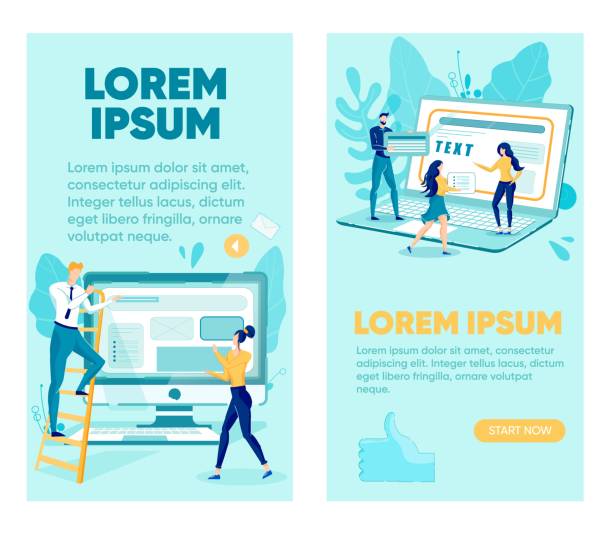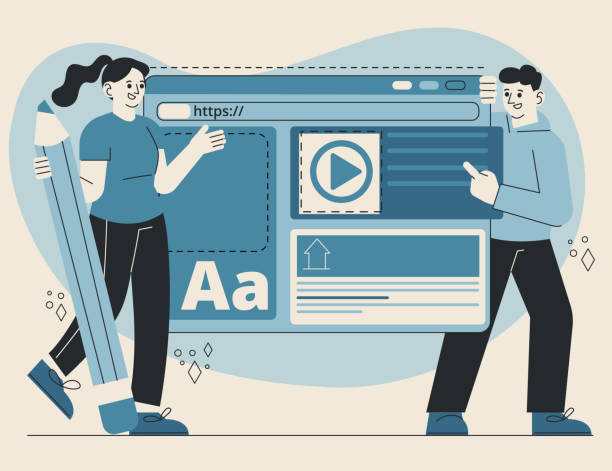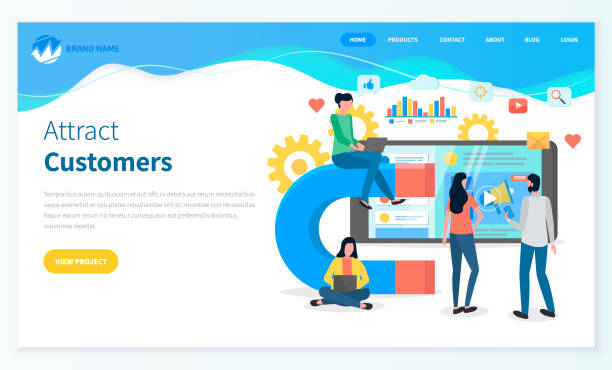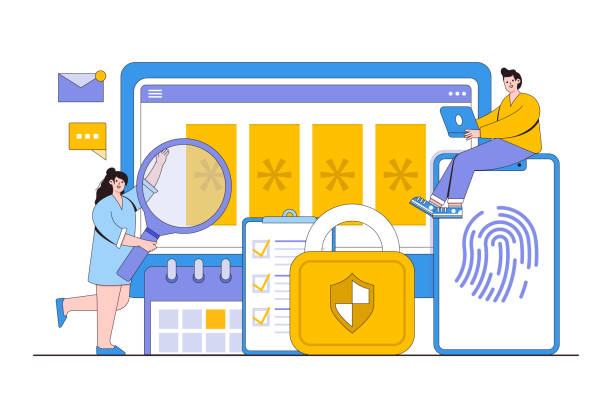The Importance of Speed in Today’s Digital World

In the current era, where everything is changing at a dizzying pace, website loading speed is considered one of the most vital factors for the success of any online business.
Internet users no longer have the patience to wait, and if a website does not load within a short period, they will likely abandon it and move on to your competitors.
This is an #analytical fact that can be proven with statistics and figures.
Fast website design not only improves user experience but also directly impacts conversion rates and customer loyalty.
A fast website allows users to access the information they need, purchase a product, or receive services without interruption.
Imagine you’ve entered an online store, and every time you click on a product, you have to wait 20 seconds for the page to open; would you continue shopping? Certainly not.
The same example applies to the world of the web.
The goal of fast website design is to provide a #user-friendly and smooth experience for visitors.
This issue becomes doubly important, especially for e-commerce sites, news portals, and blogs with high traffic.
A slow website can harm your #online reputation and even cause you to lose a large portion of your potential audience.
Therefore, the importance of web speed goes beyond a mere technical issue and has deep marketing and commercial dimensions.
Website speed optimization is no longer a luxury option but a #professional necessity for survival and competition in the web space.
Are you tired of losing business opportunities due to not having a professional corporate website?
RasavWeb, with its professional corporate website design, helps you:
✅ Build a powerful and reliable image for your brand
✅ Convert website visitors into loyal customers
⚡ Get a free consultation now!
Fundamental Concepts Influencing Web Speed

To achieve a fast website design, understanding the fundamental concepts that affect website loading speed is essential.
One of these concepts is file size optimization.
The smaller the size of images, CSS files, JavaScript, and fonts, the shorter the page loading time will be.
This is a basic #educational point that many web designers overlook.
Another concept is the number of HTTP requests.
Every element on a web page (such as images, stylesheets, scripts) creates a separate HTTP request to the server.
Reducing the number of these requests by combining files or using techniques like CSS Sprites can significantly increase speed.
This part of #fast web development requires precision and planning.
The third and very important concept is the use of Content Delivery Networks (CDNs).
CDNs store copies of your website’s content on various servers worldwide.
When a user accesses your website from a specific location, the content is delivered to them from the closest CDN server, which reduces physical distance and consequently drastically increases loading speed.
This #specialized solution is crucial for websites with global audiences or high traffic.
Furthermore, Caching plays a key role in improving speed.
Caching allows users’ browsers to store local copies of your website files so that on subsequent visits, there’s no need to re-download them, and pages load much faster.
This is a #practical guidance for anyone looking to increase their site’s loading speed.
Therefore, understanding and implementing these fundamental concepts form the backbone of a high-speed website.
Client-Side Optimization for Fast Website Design

Client-side optimization plays a crucial role in fast website design.
This process includes a set of techniques aimed at reducing the time required for the user’s browser to download, parse, and render page content.
One of the most important of these techniques is image optimization.
Large, uncompressed images can significantly increase page loading time.
Using appropriate image formats (such as WebP), lossless compression, and lazy loading (lazy loading) for images, can have a tremendous impact on speed.
This is a key part of any #guide for improving web performance.
Additionally, compressing CSS and JavaScript files, and removing unnecessary and unused code (minification), are other essential actions.
Another important aspect is font optimization.
Using high-volume web fonts can lead to website slowness.
Choosing optimized fonts, using modern formats (such as WOFF2), and loading only necessary subsets of fonts, are effective methods in this regard.
#Questionable content regarding font loading often includes discussions about the impact of the number of fonts and weight variations on performance.
Finally, adhering to principles related to render-blocking resources is important.
CSS and JavaScript files that load before the main page content can disrupt the user experience.
Asynchronous (async) or deferred (defer) loading of these files allows the browser to display visible content to the user faster, which directly contributes to creating a high-speed website.
Table: Comparison of Image Formats for Speed Optimization
Choosing the right image format can significantly impact page loading speed.
| Image Format | Best Use | Compression Capability | Transparency (Alpha Channel) |
|---|---|---|---|
| JPEG | Real photos, images with high color gradients | Very Good (Lossy compression) | No |
| PNG | Logos, icons, images with precise details, transparency needed | Good (Lossless compression) | Yes |
| GIF | Animated images, small icons | Medium (limited to 256 colors) | Yes (1-bit only) |
| WebP | Most uses (JPEG and PNG replacement) | Excellent (up to 30% smaller than JPEG/PNG) | Yes |
| AVIF | Best future-proof format (high quality, low size) | Excellent (up to 50% smaller than JPEG/PNG) | Yes |
Note: Always start with formats supported by most browsers and then gradually migrate to newer formats.
The Role of Server and Backend in Building a Fast Website

Alongside client-side optimization, server performance and backend optimization are also vital factors in building a fast website.
Choosing appropriate hosting is the first step.
A high-quality host with powerful servers and sufficient bandwidth provides the foundation for a high-speed website.
Cheap shared hosting might seem tempting at first, but it often leads to reduced speed because server resources are divided among many websites.
This is an #explanatory fact that you should consider when choosing your hosting provider.
Using dedicated servers, VPS, or cloud hosting can dramatically improve performance.
Database Optimization also holds special importance.
Dynamic websites that retrieve their content from a database can slow down due to inefficient queries or bulky databases.
This includes database cleanup, proper table indexing, and database caching.
Additionally, Server-side Caching, such as caching entire pages or their fragments, can significantly reduce server response time.
This is a #specialized solution that reduces the load on the server and delivers information to the user faster.
Gzip compression for HTTP responses is also a standard method that reduces the volume of data sent from the server to the browser.
Correct configuration of web servers like Apache or Nginx is also effective in providing optimal website performance.
These measures ensure that your backend infrastructure performs optimally to deliver a fast website design.
Are you dissatisfied with the low conversion rate of visitors to customers on your e-commerce site?
Solve this problem forever with professional e-commerce website design by RasavWeb!
✅ Significantly increase conversion rates and sales
✅ Create an excellent user experience and build customer trust
⚡ Get a free e-commerce website design consultation from RasavWeb!
Advanced Tools and Technologies for Fast Website Design

In today’s world, numerous tools and technologies are available to achieve fast website design, and using them can significantly improve website performance.
One of the most widely used tools is Google PageSpeed Insights, which allows you to analyze your website’s speed and receive suggestions for improvement.
Other tools like GTmetrix and Pingdom Tools also provide comprehensive and precise information about loading time, HTTP requests, and overall site performance.
These tools are essential for anyone seeking #deep analysis and identifying bottlenecks in their website.
In the realm of technologies, using lightweight and optimized JavaScript frameworks and libraries, such as React or Vue.js (if needed), instead of heavy frameworks, can help create fast websites.
Also, for static content and blogs, using Static Site Generators like Jekyll or Gatsby can dramatically increase loading speed, as there is no need for server-side processing on each visit.
This is an #educational solution for those who want to work with new technologies.
In terms of image optimization, software like Photoshop with its Save for Web feature or online image compression tools like TinyPNG are very useful.
These tools allow for optimal image compression without noticeably reducing visual quality.
By properly using these tools and technologies, a high level of performance in creating high-speed websites can be achieved.
The Impact of Web Speed on User Experience (UX)

Fast website design directly impacts user experience (UX), and this is one of the most important reasons to pay attention to it.
Today’s users are impatient and have low tolerance; according to research, most users expect a website to load in less than three seconds.
Every additional second of loading delay can lead to an increased Bounce Rate and reduced user engagement.
A slow website creates a sense of frustration and distrust in the user and can harm the brand’s reputation.
This is an important #analytical point in the field of UX.
When a website is fast, users can easily navigate between pages, quickly find the information they need, and continue their activities without any hindrance.
This fluidity in interaction creates a sense of satisfaction and efficiency in the user, encouraging them to spend more time on your website and ultimately become loyal customers.
For example, an e-commerce website that loads quickly allows users to quickly view products and add them to their cart, which directly impacts sales conversion rates.
It can be intensely #entertaining to see how small improvements in speed lead to a significant increase in user satisfaction and profitability.
Therefore, investing in website speed optimization is not just a technical decision but a smart strategy to improve user experience and increase business success.
The Connection between Web Speed and Search Engine Optimization (SEO)

Another critical aspect of fast website design is its direct impact on Search Engine Optimization (SEO).
Search engines like Google consider website loading speed as an important ranking factor.
Websites that load faster offer a better user experience, and this is rewarded by Google’s algorithms.
Consequently, high-speed websites have a greater chance of achieving higher rankings in search results.
This is an important #news for every webmaster looking to increase their site’s visibility and organic traffic.
Furthermore, web speed affects other important SEO metrics such as Crawl Rate and Bounce Rate.
Search engine bots (like Googlebot) have a limited budget for crawling your web pages; if your website is slow, these bots cannot crawl and index enough of your pages, which means losing ranking opportunities.
Also, as previously mentioned, low speed leads to an increased bounce rate, which is a negative signal to search engines indicating that users are not satisfied with your website.
Therefore, high-speed web design is not only beneficial for users but also a fundamental strategy for improving SEO and increasing organic traffic.
Investing in speed optimization will yield significant returns in search results and help you surpass competitors.
Table: Impact of Site Speed on SEO Factors
Improving website speed directly impacts your SEO ranking and performance.
| SEO Factor | Impact of High Speed | Impact of Low Speed |
|---|---|---|
| Google Ranking | Improved ranking (direct ranking factor) | Ranking drop or non-appearance in top results |
| Crawl Rate | More pages crawled by bots | Fewer pages crawled, new content not indexed |
| Bounce Rate | Reduced bounce rate, increased user engagement | Increased bounce rate, negative signal to search engine |
| Time on Site | Increased time on site and pages viewed | Reduced time on site and quick abandonment |
| User Satisfaction | High satisfaction, likelihood of return visits | Dissatisfaction, negative experience, no return |
These factors synergistically impact your website’s overall SEO performance.
Common Mistakes in Website Design and Slow Loading

Despite the great importance of fast website design, there are some common mistakes that lead to slow website loading.
One of the biggest mistakes is the lack of image optimization.
Many designers and developers upload images without proper compression or resizing, which can consume a large amount of bandwidth and drastically increase loading time.
This is a #questionable content point as to why, despite numerous tools, many websites still struggle with this issue.
Another mistake is the excessive use of plugins and heavy JavaScript scripts.
Each additional plugin or script can generate more HTTP requests and slow down browser processing.
Careful selection of plugins and using only essential ones is crucial.
Also, the lack of caching, both client-side and server-side, is one of the main reasons for slow websites.
Caching helps temporarily store data and prevents repeated content downloads.
This is a fundamental #guidance for anyone looking to improve their website’s performance.
Finally, neglecting optimized and clean coding, using scattered and uncompressed CSS and JavaScript codes can also lead to slowness.
To ensure creating a high-speed website, special attention must be paid to these technical points from the outset, and these common mistakes must be avoided.
Does your current e-commerce site design lead to losing customers and sales?
RasavWeb, with its modern and user-friendly e-commerce website designs, is your solution!
✅ Significantly increase conversion rates and sales
✅ Strong branding and building customer trust
⚡ Get a free e-commerce website design consultation from RasavWeb!
Continuous Maintenance and Monitoring to Maintain Site Speed

Fast website design is not just about the initial launch of a high-speed website; it also requires continuous maintenance and monitoring.
Websites are living entities that, over time, with the addition of new content, plugin installations, and system updates, may lose their initial speed.
Therefore, regular monitoring of website performance using analytical tools such as Google PageSpeed Insights, GTmetrix, or Google Analytics is essential.
This continuous monitoring allows you to quickly detect any speed drops and take the necessary actions to resolve them.
This is an ongoing #education that should be part of every webmaster’s work plan.
Regular updates of the Content Management System (CMS) like WordPress, plugins, and themes also play an important role in maintaining website security and speed.
Newer versions typically include performance and security improvements.
Additionally, periodic database optimization by removing redundant data and repairing tables can help maintain optimal performance.
Checking for broken links, dead images, and outdated code are also actions that should be performed periodically.
This type of #explanatory and #specialized maintenance ensures that your high-speed web design remains robust in the long run and preserves an optimal user experience for visitors.
The Future of Web Design and Speed in Web 3.0

The future of fast website design in the world of Web 3.0 and beyond looks very exciting.
With the advent of technologies such as blockchain, artificial intelligence, and the Internet of Things (IoT), the need for websites capable of processing and displaying data at unprecedented speeds is felt more than ever.
Web 3.0, based on decentralization and intelligent interactions, requires web architectures that can handle a massive volume of information and transactions.
This is an #analytical topic that opens up new horizons.
The development of more advanced CDNs, the utilization of new network protocols like HTTP/3, and the expansion of Edge Computing, which processes data closer to users, all move towards website speed optimization.
The use of WebAssembly for executing high-performance code in the browser, as well as advancements in PWA (Progressive Web Apps) technologies that provide a mobile app experience on the web, are other important trends in creating high-speed websites.
These technologies enable developers to build websites that are not only fast but also highly responsive and efficient.
Therefore, focusing on speed and efficiency is not just a current need but an investment for a future where the web will play a more prominent role in our daily lives and will be #exciting news for all participants in this field.
Frequently Asked Questions
| Question | Answer |
|---|---|
| What does fast website design mean? | Optimizing a website for fast page loading in users’ browsers, which leads to a better user experience and higher search engine rankings. |
| Why is website loading speed important? | Increased user satisfaction, reduced Bounce Rate, improved SEO, and increased conversion rates, as users expect websites to open quickly. |
| What factors affect website speed? | Image size, unoptimized coding (CSS, JS, HTML), inappropriate hosting choice, lack of caching, high number of HTTP requests, and lack of CDN usage. |
| How can website loading speed be improved? | Image compression, code optimization and compression, using caching, enabling Gzip compression, using a CDN, and choosing powerful hosting. |
| What is a CDN and how does it help website speed? | A CDN (Content Delivery Network) stores website content on various geographical servers and delivers content from the closest server to the user, which reduces loading time. |
| What is the role of hosting in website speed? | Very significant. Powerful and suitable hosting with sufficient resources, high bandwidth, and optimized servers forms the foundation of a website’s speed. |
| How does image optimization affect website speed? | Images are usually the heaviest part of a web page. Compressing and optimizing them without significant quality loss drastically reduces page size and increases loading speed. |
| Does website speed affect SEO? | Yes, Google and other search engines consider website speed as one of the ranking factors. Faster sites have a higher chance of ranking higher. |
| What tools are available to measure website speed? | Google PageSpeed Insights, GTmetrix, Pingdom Tools, and Lighthouse, each providing reports and suggestions for speed improvement. |
| How does Caching help website speed? | Caching allows static website content to be stored for subsequent user visits. As a result, the browser does not need to re-download all content, and pages load much faster. |
And other services of RasavWeb Advertising Agency in the field of advertising
Smart Custom Software: A fast and efficient solution for improving SEO rankings with a focus on proprietary programming.
Smart Digital Branding: A new service to increase user engagement through the use of real data.
Smart Advertising Campaign: A combination of creativity and technology to attract customers through marketing automation.
Smart Website Development: A dedicated service for online growth based on proprietary programming.
Smart Data Analysis: A new service to increase customer acquisition through marketing automation.
And over a hundred other services in the field of internet advertising, advertising consultation, and organizational solutions
Internet Advertising | Advertising Strategy | Advertorials
Sources
Website Speed Optimization
Increase Website Speed
Increase WordPress Site Speed
Reasons for Website Slowness
? For your business to leap forward in the digital world, RasavWeb Afarin Digital Marketing Agency, with years of experience in providing services such as e-commerce website design, SEO, and online advertising, paves your path to success.
📍 Tehran, Mirdamad Street, next to Bank Markazi, Southern Kazeroon Alley, Ramin Alley, No. 6




